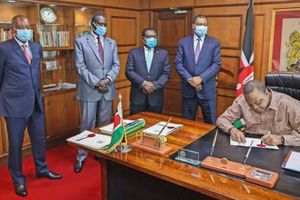Craft roadmap for the reopening of economy
What you need to know:
- The curfew will henceforth start from 9pm till 4am, from the current 7pm to 5am schedule.
- Saturday, some 126 new cases were reported, raising the cumulative figure to 2,600.
- Three months of partial lockdown have taken a heavy toll on the citizens and the country at large.
Kenyans will have to wait longer to regain their full freedom. Restrictions to contain the coronavirus will continue for another 30 days and with painful consequences at personal, communal and national levels.
Contrary to high expectations, President Uhuru Kenyatta has extended the night-time curfew for another 30 days with the only relief being reducing the hours by three.
The curfew will henceforth start from 9pm till 4am, from the current 7pm to 5am schedule.
In all, it was an anti-climax, given the President’s earlier assertion that the lockdowns cannot go on indefinitely, which was interpreted as a concession to vacate them at the opportune time.
CONTAINMENT MEASURES
However, yesterday, President Kenyatta was emphatic that the containment measures were inevitable to avert a spike in infections and create an unmitigable disaster.
Indeed, infections have been on the increase in recent weeks as the government intensified testing.
Saturday, some 126 new cases were reported, raising the cumulative figure to 2,600. Experts argue that the figures could have been worse if the government had not laid out the containment directives in March that included dusk-to-dawn curfew, cessation of movements in and out of hotpots like Nairobi and Mombasa, ban on gatherings like worship and closure of all educational institutions.
For Kenyans, Saturday was like a date with destiny. An overwhelming majority of citizens had expected the President to lift the restrictions to reopen the economy.
Three months of partial lockdown have taken a heavy toll on the citizens and the country at large. The economy has tanked due to a drastic fall in productivity arising from restriction of movements.
Shutdown of various sectors such as aviation and long-distance road travel, hospitality and tourism and education, among others, have resulted in massive revenue losses and consequent job cuts.
Most small-scale businesses have closed. Matters have been made worse by the collapse of global and national supply chains cutting off most businesses.
TRAVEL BANS
At the social level, travel bans and confining people to work from homes have spawned psychological and even health complications. Depression is increasing as many people lose jobs and are forced to stay indoors without any hope and means of releasing pressure. Which explains the growing levels of domestic violence and child abuse. Cumulatively, the full impact of the lockdown will be huge when everything finally settles.
Yet, for the government, lifting the restrictions is fraught with grave dangers. Experiences have been cited of countries such as South Korea, Malaysia and Pakistan, which reopened and were forced to close again as infections spiked to unmanageable levels. The government’s fear is that unless the coronavirus infection is contained, it can overwhelm the health system, which even at the best of times, is overstretched and unable to cope with demands of the sick.
After extending the restrictions, President Kenyatta has to address the question, what next? For how long will the restrictions go on? What is the endgame?
Extension of the regulations is the easiest path but that does not resolve the problem at hand. The government has to provide a clear roadmap of how it is dealing with the crisis. Presently, there is a sense of helplessness that is quite unnerving.
WORSHIP PLACES
It is not lost that in his address, the President outlined some action points, among them, hosting a meeting of governors next Wednesday to assess the state of county’s preparedness to deal with the pandemic. Education and Health ministries have also been tasked to craft a return-to-school calendar and formula while the Interior ministry was asked to work with religious organisations to determine when to reopen worship places.
Arguably, there have been several stakeholder consultations across the sectors before, which by now, should have yielded tangible outputs. Those are yet to be seen. Now that more are being convened, citizens will be waiting to see if they yield realistic outcomes.
The point we are making is that the country cannot continue with the lockdowns forever. There must be a strategic plan for exit and importantly, to put the country back on recovery. So far, the government has announced economic stimulus packages intended to cushion and lift the vulnerable from the rut. In practical terms, the impacts are yet to be felt. In the meantime, public debt is rising to astronomical levels.
Coronavirus is here with us; it is not going away any time soon. Therefore, the government has to craft plans that enable the citizens to carry on with their lives within the context of an incurable disease. Restrictions should only be temporary but not a way of life.


